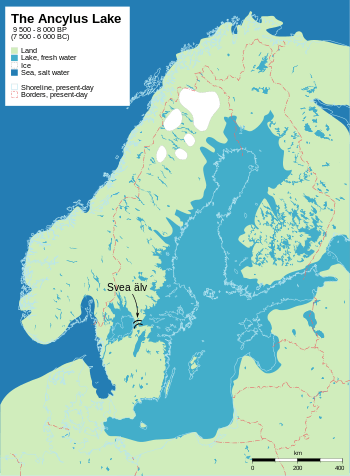Ancylus Lake
| Evolution of the Baltic Sea |
|---|
| Pleistocene |
|
Eemian Sea (130,000–115,000 BP) Ice sheets and seas (115,000–12,600 BP) |
| Holocene |
|
Baltic Ice Lake (12,600–10,300 BP) Yoldia Sea (10,300–9,500 BP) Ancylus Lake (9,500–8,000 BP) Mastogloia Sea (8,000–7,500 BP) Littorina Sea (7,500–4,000 BP) Modern Baltic Sea (4,000 BP–present) |
Ancylus Lake is a name given by geologists to the body of fresh water that replaced the Yoldia Sea after the latter had been severed from its saline intake across central Sweden (with the eastern end of the channel near present Stockholm) by the isostatic rise of south Scandinavian landforms. The dates are approximately 9500–8000 BP calibrated, during the full Boreal period. The lake became the Littorina Sea when rising oceanic levels broke through the Great Belt.
The lake was named by Gerard de Geer after Ancylus fluviatilis, a gastropod found in its sediments.

Description
The elevation of southern Sweden did not entirely block the flow across central Sweden. Some egress continued from the lake through the Göta and Steinselva rivers, which exit Vänern to the Kattegat. Salt water did not enter the lake, however, which became entirely fresh as the lake rose above sea level. The date at which the flow was certainly blocked is about 8000 BP, when nearby Lake Vättern (part of the waterway system) became severed from Ancylus Lake.
The result of increasing lake levels was the Ancylus transgression, a general flooding around its shores, 9500–9200 BP. By this time an enlarged Gulf of Bothnia and parts of Norway were free of ice, while the Rovaniemi region of Finland appeared no later than 9000 BP, despite the new flooding.
Accelerated melting and the rebound of land surfaces at different rates in different locations led to some instability. By 9200 BP the lake rose over the Dars sill and cut a new channel in the vicinity of what is now the "Great Belt" (the channel between the Danish islands of Zealand and Funen), which some geologists call the Dana River. For a time, Skåne, or southern Sweden, was an island once more, from about 9200 to no later than 8000 BP. The lake level began to drop.
North Scandinavia
By 9000 BP the northern channel ceased functioning, joining Skåne to Sweden rather than to Denmark. However, only an isthmus connected Skåne to the new northern lands. If Skåne became an island geographically, it must have been no later than the Ancylus Lake phase. At that time Mesolithic cultures moved into newly released land around the shores of the Gulf of Bothnia. They were fishing along the shores, hunting seals and following the reindeer into their new ranges.
In Lapland Mesolithic fishers, hunters and probably herders found pine-birch forest with tundra-like open spaces. In addition to pinus and betula were aspen, alder, willow, crowberries, grass and sedge. Much of the new Finnish land was covered by mire. Moraine ridges and drumlins formed an extensive island system. The shores around the lake were stony ground.